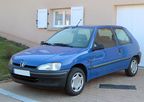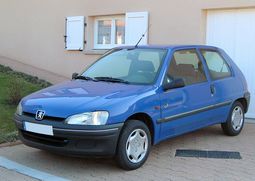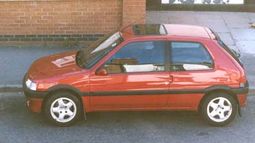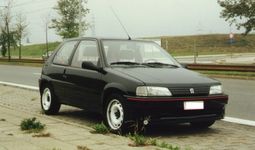The History Of Peugeot 106

The Peugeot 106 is a supermini produced by French automaker Peugeot from 1991 to 2003. It also formed the basis of one of the earliest commercially successful electric cars.
The Peugeot 106 was introduced in the autumn of 1991, as the French marque's entry level car slotting in beneath the 205 - although it is now largely considered the 'true' replacement to the 205. It was a substantial development of the Citroën AX. It was heavier, safer, more solid feeling than the AX or 205. It was aimed directly at the Renault Clio which had gone into production a year earlier, and as a more modern alternative to the slightly larger 205 which had been a massive success for Peugeot and was still proving popular almost a decade after its launch. Winning praise for its modern styling, comfortable ride, excellent handling and cheap running costs, the 106 quickly became popular. Going against the appeal were limited interior space and low-rent interior plastics.
Sales in the UK were strong, with the 106 being the 11th most popular new car in the country in 1993.
Its power came from 1.0-litre and 1.1-litre carburettor petrol engines and a 1.4-litre fuel injection unit, as well as a 1.4L Diesel engine which was later dropped in mid/ late 1994 and replaced with a more refined and more economical 1.5-litre unit of 1527cc. A 1.6-litre fuel injected engine was introduced on the 1995 XSi model, with 120 mph (193 km/ h) top speed.
In the UK trim levels were basic XN, mid-range XR, top-spec XT, and the sporty XSi model mentioned above. In addition, from 1994 onwards there was a "Rallye" model offered. This was different from the XSi model with the TU2 series 1.3 litre petrol injection engine (100 bhp). This was designed for clubman rallying and the sporting driver, and had little in the way of creature comforts, such as electric windows, power assisted steering etc. On the phase 1 model, a sunroof and anti lock brakes were the only options available from the factory, although many came with foglights or spoilers from the XSi models. In Portugal there was a special edition of 50 units of the Rallye, called R2, which feature extensive use of sporting material from the Peugeot-Talbot racing division which went even further with the extreme nature of the Rallye, with changes to the suspension, brakes, new 14inch speedline rims, racing seatbelts, and engine management and exhaust upgrades to produce 106PS.
In early 1996 the Peugeot 106 also formed the basis for the near identical Citroën Saxo, and at this time the 106 received a facelift which saw all engines get fuel injection and equipment levels raised. The XSi was dropped in favour of the new GTi model with a 1.6 16v engine.
From 1997-1998 the Phase 2 Rallye was offered, and these combined the light, nimble chassis of the Phase 1 Rallye, with a 1.6 litre petrol injection engine (TU5J2, 103 bhp) and updated looks and safety features of the later models (1996-1999). Optional Extras on the Phase 2 Rallye were; Power assisted steering, airbag and a sunroof. From 1996-1999 trim levels were XN, XL, XR, XT, XS and GTi. In France a five-door version of both XS and GTi versions were offered.
At the end of 1998, the Peugeot 106 range was the 1.1L petrol (Independence, XN, XL, XT Look or Zest 1/ 2/ 3), 1.4 petrol (XR, Roland Garros or Quiksilver), 1.6 8v petrol (XS or Rallye) and 1.5L diesel (XND) models as well as the 1.6 16v petrol (GTi) - no 1.0 model anymore, 1.6 16v model gained. This was due to the launch of the larger 206, which stole many sales from the 106. Peugeot initially intended to phase the 106 out and market the 206 as its replacement, but later decided to replace the 106 with another all-new model.
After 12 years in production, the last Peugeot 106 rolled off the production line late in 2003. Its replacement, the 107, has been available since early 2005. By the time production ceased, the Peugeot 106 was one of the longest running production cars still made in Europe but it was still proving fairly popular, especially in its home market of France.
Although it was being left behind by more modern cars with more in the way of quality, refinement, space and comfort, it was still considered one of the best drivers' cars on the European mini-car market.
- 1.0 L (954 cm³),TU9 engine, straight-4, OHC, 8-valve, 50 PS. This engine is fitted in most of the cars sold in Brazil, because of a tax on engines over 1.0 litres.
- 1.1L (1124cc) TU1 I4, 60PS (59hp/ 44kW) and 65ft·lbf (89N·m)
- 1.3L (1294cc) TU2'(TU2J2)' I4, 101PS (100hp/ 74kW) and 89ft·lbf (108N·m)
- 1.4L (1361cc) TU3 I4, 75PS (74hp/ 55kW) and 89ft·lbf (121N·m)
- 1.4L (1361cc) TU3 I4, 95PS (93hp/ 69kW) and 86ft·lbf (117N·m)
- 1.4L (1360cc) TUD3 Diesel I4, (50hp)
- 1.5L (1527cc) TUD5 Diesel I4, 58PS (57hp/ 42kW) and 86ft·lbf (117N·m)
- 1.6L (1587cc) TU5 I4, 105PS (103hp/ 77kW) and 97ft·lbf (132N·m)
- 1.6L (1587cc) TU5 I4, 16-valve 120PS (118hp/ 88kW) and 107ft·lbf (145N·m)
Although the interior seemed reasonably plush at the time, the low-end models did have areas of visible metal work on the doors and a generally more sparse interior. 1.0L cars were fitted with a 4 speed manual gearbox, with all other models having a 5 speed manual with an automatic gearbox as an option.
Many of the cars sold in the UK were special editions, carrying such names as Graduate, Inca and Aztec. These were often based on the XN trim vehicles, but with the addition of bodywork graphics carrying the name of the special edition, and a few other basic options such as a tilt and slide sunroof.
Most models had only basic features, with even a radio being only an option on some variants such as the 106 'Kid' special edition (which had denim effect fabrics).
No Phase I cars had power steering in right-hand drive markets such as the UK as there was no space for the power-steering pump in these cars. This was rectified in Phase II cars, where power steering was available as standard in higher specification models, or as an option on lower specification models.
Higher up the range, electric windows, manual pop-up sunroof (electric sunroof was a very rare extra), radio-cassette or radio-CD and rear wash-wipe were available. A drivers airbag was introduced in the Phase II model as an optional extra, although it came standard on late GTis.
The GTi had black leather upholstery (although early models had cloth interiors), 14" Raptor alloy wheels, a body kit and disc brakes all round. The leather was much of the reason for the increase in price over the otherwise near-identical Citroen Saxo VTS. At the time, it was also widely regarded as one of the fastest road cars in terms of "real life" point-to-point speed, thanks to very predictable handling and fast acceleration in 2nd and 3rd gears in particular.
As with the Saxo, air-conditioning was never an option on right-hand-drive 106's because the blower motor was mounted in the bulk-head on the drivers side. As a result, there was insufficient space available to accommodate the evaporator, except by first ducting the air flow to the passenger side and then at the expense of the glove-box. Although an after-market kit was available that did exactly this, the resultant pressure loss made the system noisy and ineffective. The blower motor could also not be easily relocated, since the windscreen wiper motor was mounted in the passenger side space.
In common with many small cars of the time, the standard stereo system included 5.25" drivers mounted low in the front doors and 4" drivers mounted in the rear quarter panels. This set-up could be easily improved upon by mounting separate tweeters in the A-panel trims, similar to many VW models of the time. The very thin door cards and metalwork did however leave the system very 'thin' sounding, with very poor output in the upper-bass ranges.
From Wikipedia, the free encyclopedia
More About Peugeot 106



|